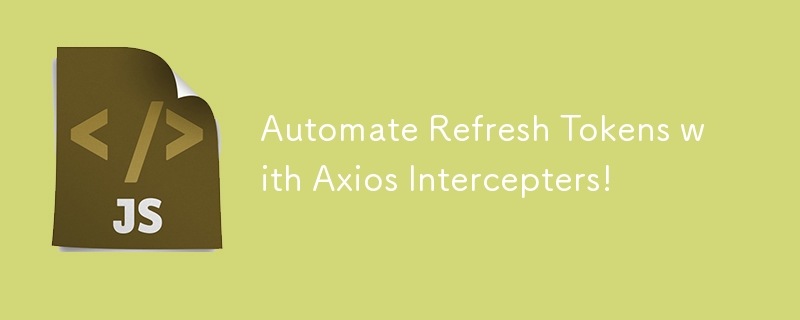Home >Web Front-end >JS Tutorial >Automate Refresh Tokens with Axios Intercepters!
Automate Refresh Tokens with Axios Intercepters!
- DDDOriginal
- 2024-10-23 06:27:29999browse

The Problem
A while back, I was working on a small project that interacted with the Salesforce API and performed CRUD operations on my objects. I was using React.js (with no backend setup, just a static frontend). However, I encountered a problem while working with the API. The access token I generate using the OAuth method is valid for only 24 hours! This means I have to manually generate a new token by making an OAuth API call every time I refresh the application.
I don’t like how my application is making unnecessary API calls to Salesforce OAuth to refresh the token, even when it hasn’t expired. To overcome this, I want to implement the following logic in my code:
axios.get('https://www.someapi.com/fetch-data').then((data)=> {
// doing something with the Data
},{}).catch((error)=> {
if(error.response.statusCode === 401){
// If Token Expired
RefreshToken()
window.alert("Session Expired Please Reload the Window!")
}
})
My logic is essentially this: if there’s a 401 response from the API endpoint, I make a refresh token API call, store the new token in local storage, and then prompt the user to reload the page to use the newly generated token for subsequent API calls. However, this approach relies on the user to perform an additional action, which could be automated to improve the user experience and avoid unnecessary interruptions.
Using Axios Intercepters
Let’s see it in action
axios.interceptors.response.use(
(response) => response,
async function (error) {
const originalRequest = error.config;
if (error.response.status === 401 && !originalRequest._retry) {
if (isRefreshing) {
return new Promise((resolve, reject) => {
failedQueue.push({ resolve, reject });
})
.then((token) => {
originalRequest.headers["Authorization"] = "Bearer " + token;
return axios(originalRequest);
})
.catch((err) => {
return Promise.reject(err);
});
}
originalRequest._retry = true;
isRefreshing = true;
return new Promise((resolve, reject) => {
initiateNewAccessTokenApi()
.then((token) => {
axios.defaults.headers.common["Authorization"] = "Bearer " + token;
originalRequest.headers["Authorization"] = "Bearer " + token;
processQueue(null, token);
resolve(axios(originalRequest));
})
.catch((err) => {
processQueue(err, null);
reject(err);
})
.finally(() => {
isRefreshing = false;
});
});
}
return Promise.reject(error);
}
);
Code Explanation
What I did was attach a middleware to every request that Axios makes, checking if any response comes back with a 401 HTTP status code. If it does, I re-initiate the access token by calling the refresh token API, store the new token in local storage, and automatically re-trigger all the previous API calls that were denied. That’s it! No more asking the user to ‘reload the window!’ ?
I hope this helps and integrates well with your work!
The above is the detailed content of Automate Refresh Tokens with Axios Intercepters!. For more information, please follow other related articles on the PHP Chinese website!
Related articles
See more- An in-depth analysis of the Bootstrap list group component
- Detailed explanation of JavaScript function currying
- Complete example of JS password generation and strength detection (with demo source code download)
- Angularjs integrates WeChat UI (weui)
- How to quickly switch between Traditional Chinese and Simplified Chinese with JavaScript and the trick for websites to support switching between Simplified and Traditional Chinese_javascript skills

